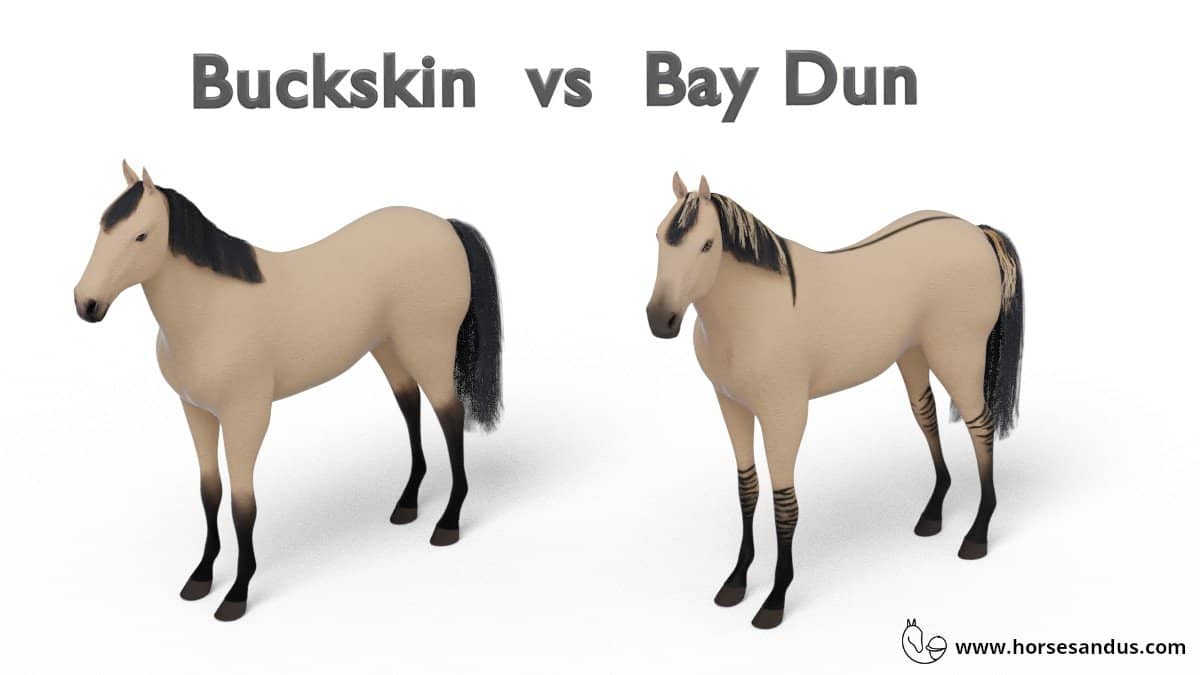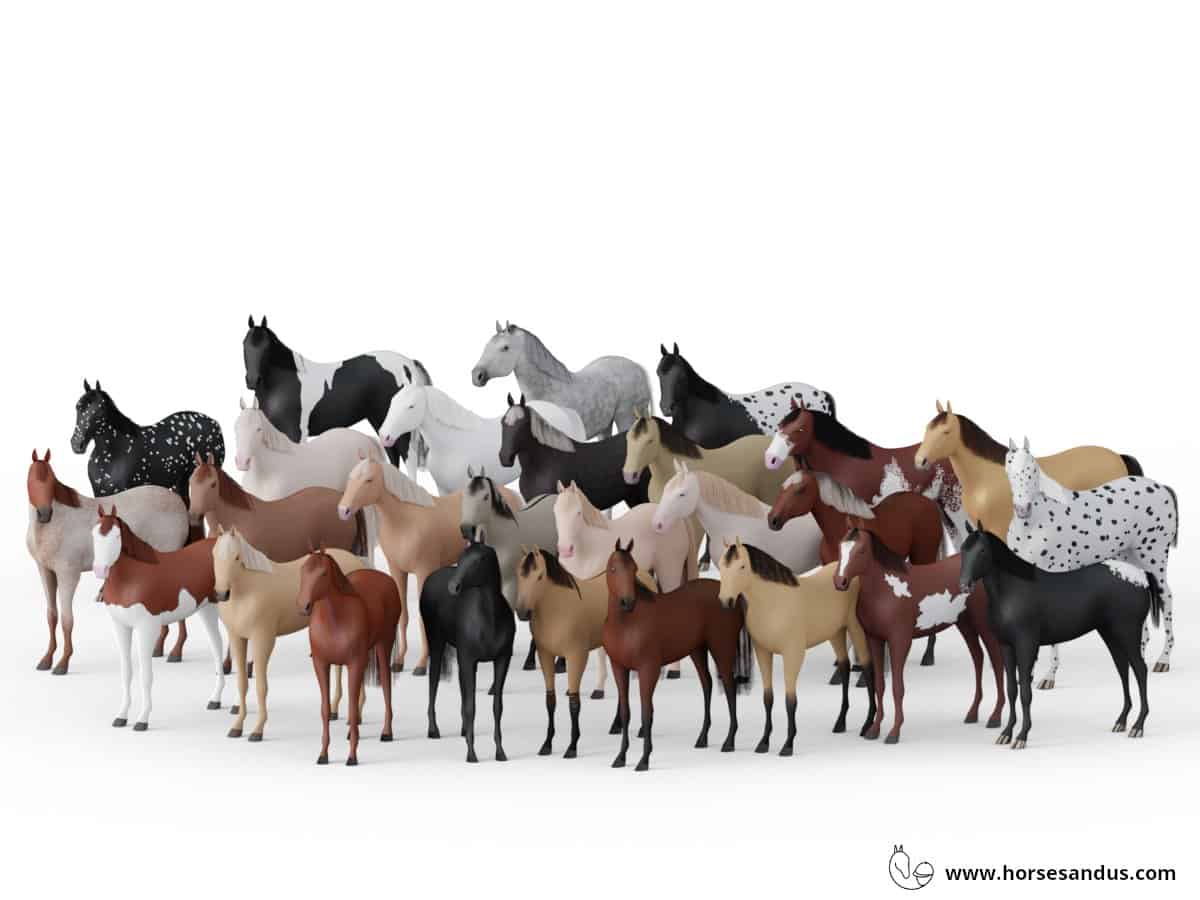The Tennessee Walking Horse also called Walking Horse or Tenessee Walker is a gaited horse breed that was created in the state of Tennessee in the 18th century, for use on the southern plantations. That is why it carries the name of this state.
It is known for its expressive and smooth, four-beat, running-walk. This comfortable gait together with its docile temperament has made the Tennessee Walking Horse an increasingly popular riding horse.
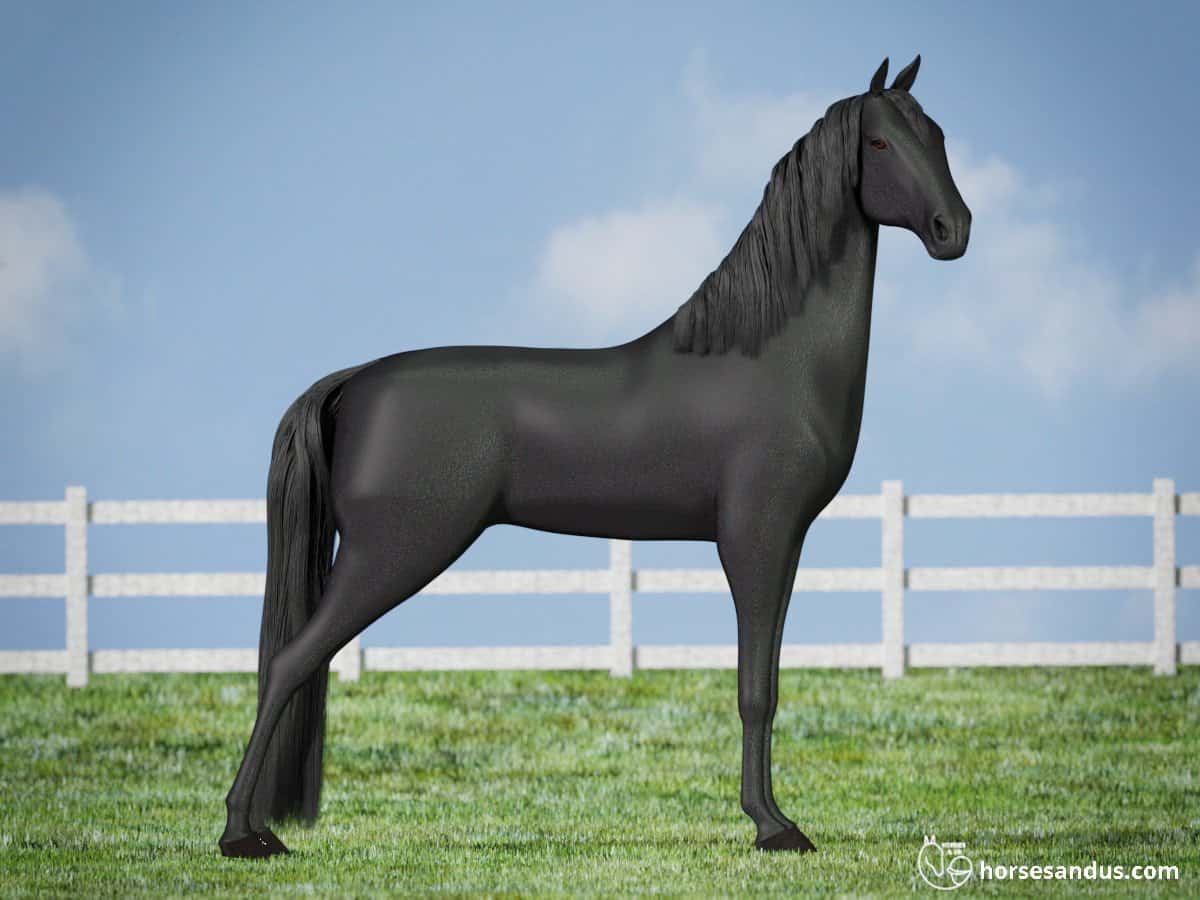
It is a composite breed that resulted from the blend of many other breeds – Narragansett Pacers, Canadian Pacers, gaited Spanish Mustangs, Morgan, Standardbred, Thoroughbred, and American Saddlebred.
Classification of the Tennesse Walking Horse
Type: Light Horse; Gaited Breed
Blood: Warm blood
Country of Origin
United States (Tennessee)
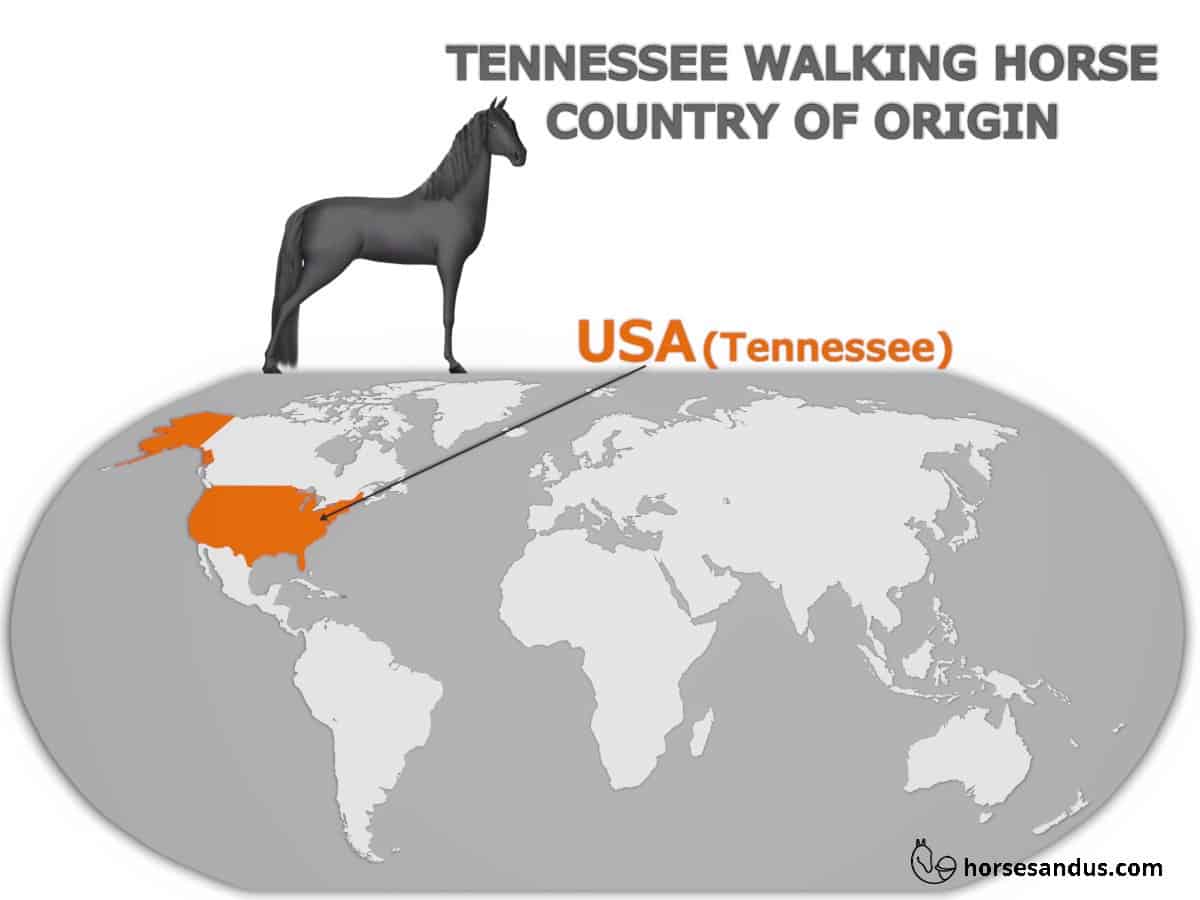
Characteristics of the Tennessee Walking Horse
The Tennessee Walking Horse is a light gaited breed with an elegant upright build giving it a noble appearance.
It is usually trained to stand in a position where the hind limbs are stretched out behind.
Show horses can be seen with their tail sticking in an upright position, but this is not a natural characteristic of the horse. This effect is obtained through controversial tail alteration procedures like tail nicking and tail bracing.
Height
The height of the Tennessee Walking Horses generally ranges from 148 to 173 cm (14.3 to 17 hands height).
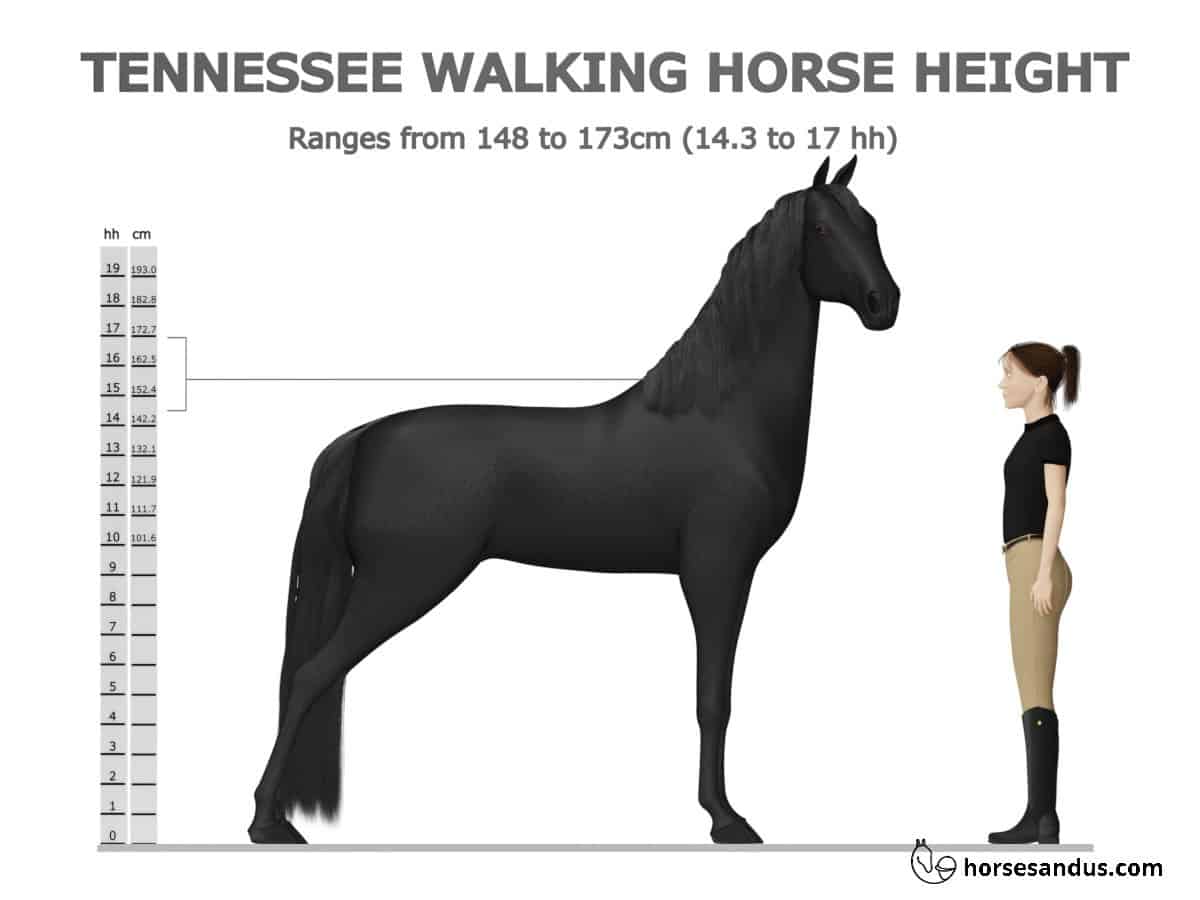
Conformation
The ideal conformation (physical appearance) of the Tennessee Walking Horse typically has the following characteristics:
- Long Head with a straight profile
- Medium to small ears, pointing forward
- Long, curved, high-set neck
- Long sloping shoulder
- Well defined withers extending beyond the top of the shoulder
- Short-coupled body with square-shaped barrel
- Topline is level or slightly sloping to the hindquarters
- The bottom line is longer than the top line, allowing a long stride
- Slightly sloping croup, almost horizontal
- Long flat legs, free of puffiness
- Long, thick mane and tail
- High set tail
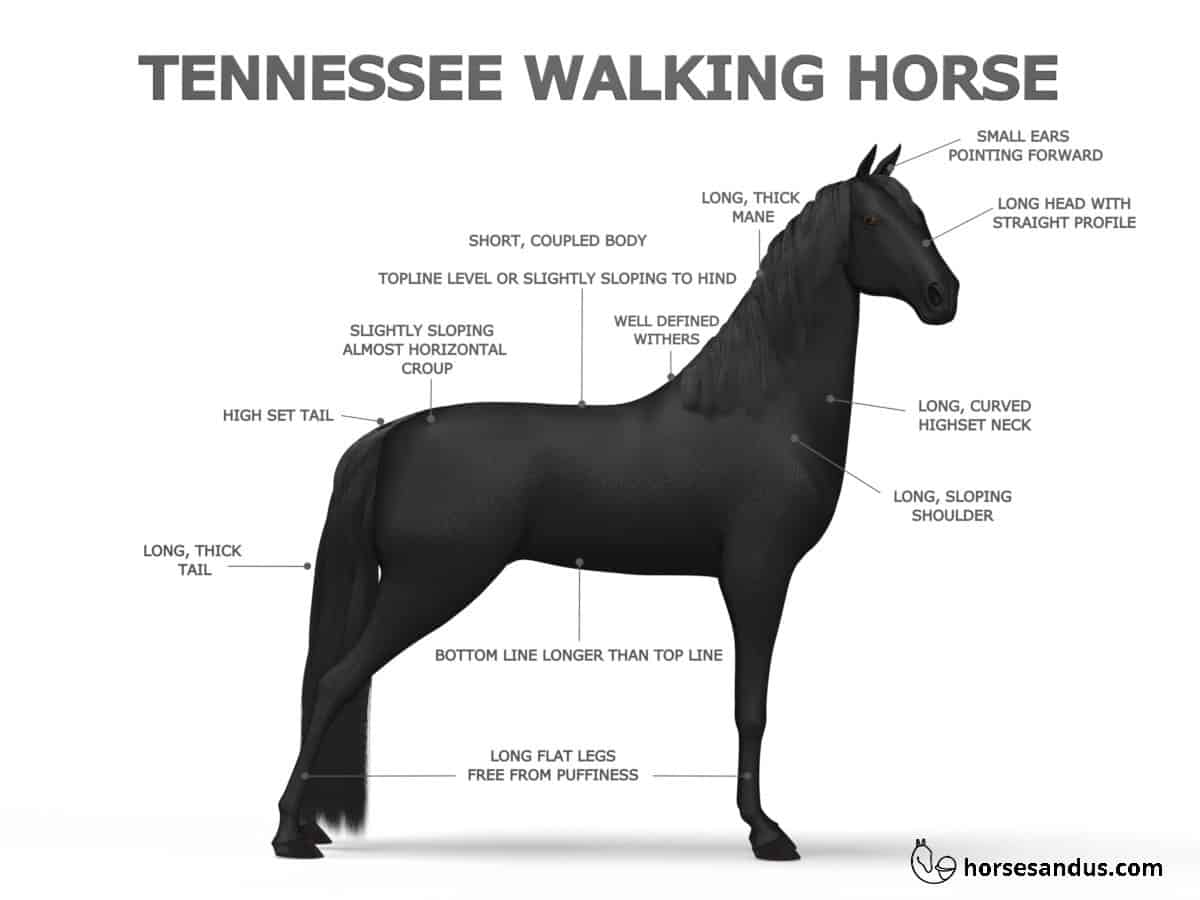
Temperament
Tennesse Walking Horses are calm and friendly with a docile temperament, making them great companion horses.
They are easy to train because they are willing to listen and learn. This makes them usually very reliable for inexperienced riders.
Color
The Tennessee Walking Horse can have a wide range of colors and patterns. From the base colors such as bay, black, and chestnut to the diluted colors like dun, palomino, buckskin, cremello, champagne, and silver.
They can also be seen with white patterns such as overo, tobiano, sabino, and so on.
Their coats can also be Grey or Roan.
Longevity
The Tennessee Walking horse is a robust breed that has a long life span up until 30 years.
The Unique Gaits of the Tennessee Walking Horse
The Tennesse walking horse performs three distinct gaits: The Flat Foot Walk, the Running Walk, and the Canter.
Yet it is most known for the running walk, which is unique to this breed.
These are the natural gaits of the Tennessee Walking Horse, but unfortunately, they are magnified with the help of heavy shoes, chains, or soring, to create flashy gaits for competition in shows.
Some Tennessee Walking horses are multi-gaited and can additionally perform other four-beat gaits like the fox trot, rack, and stepping pace. Although these gaits are smooth and easy to ride they are not desired in competitions or breeding plans.
The Flat Foot Walk
The flat foot walk is similar to the regular walk that is universal to all horses, but it is faster, more energetic, and long-reaching.
The speed of the flat foot walk is from 4 to 8 miles per hour (6.4 to 12.8 km per hour).
It is characterized by:
- High-stepping forelimbs with an extended reach.
- Overstriding with the hind foot overreaching the fore foot imprint up until 14 inches (35 cm )
- Head-and-neck nodding in rhythm with the feet
- Relaxed ears flicking forward and backward
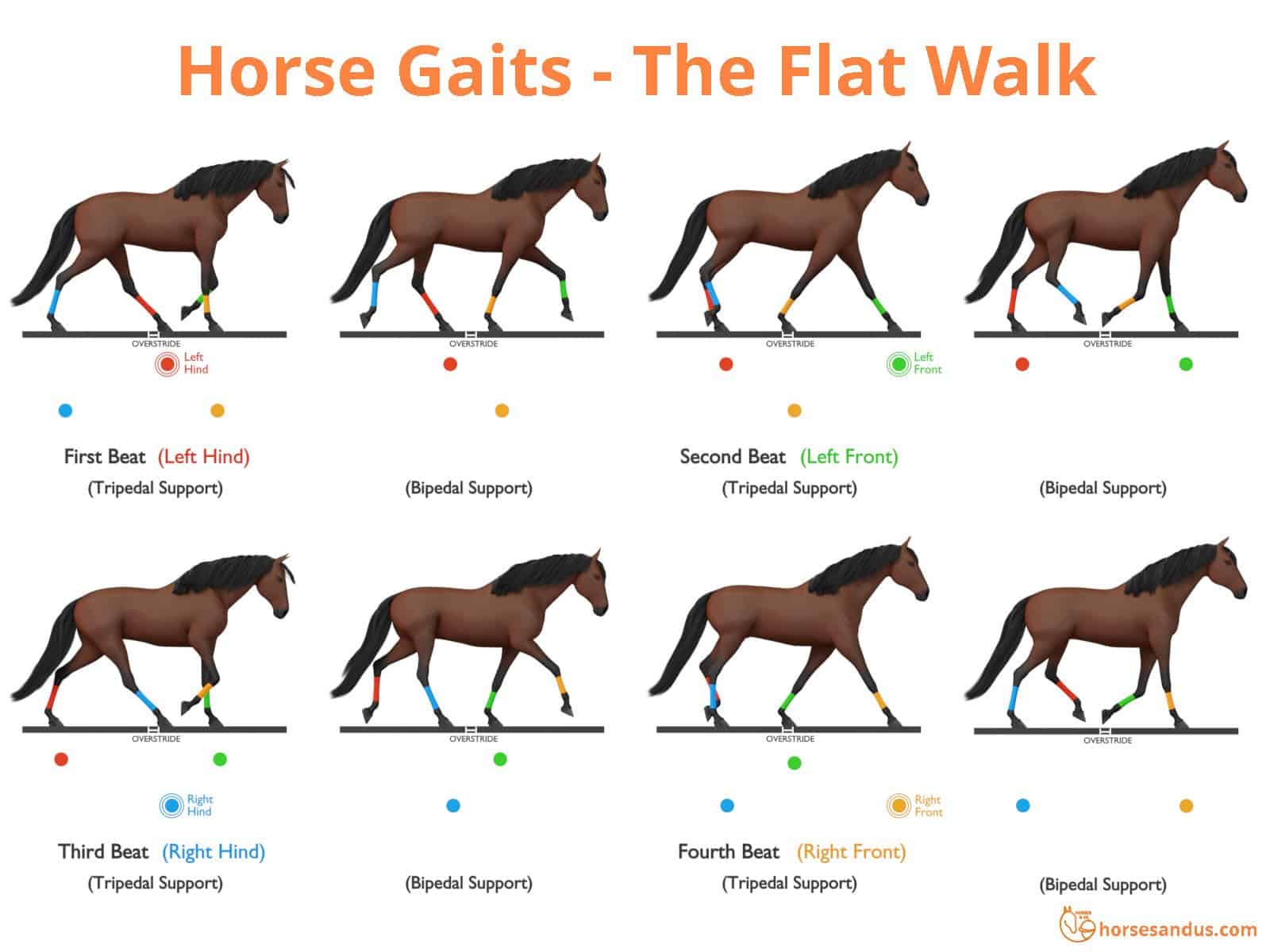
It is a symmetrical, four-beat, lateral gait.
The footfall sequence is left hindleg, left foreleg, right hindleg, right foreleg.
Ideally, the four footfalls are equally spaced in time.
The support phases alternate between bipedal (2-foot support) and tripedal (3-foot support).
Animation of the Flat Foot Walk
The Running Walk
The running walk is basically a more powerful version of the flat foot walk.
- There is more push from behind with an increased overstride up to 24 inches (61cm).
- The speed is increased, reaching 10 to 20 miles per hour (16 to 32 km per hour).
- The head-and-neck nodding is faster due to increased speed.
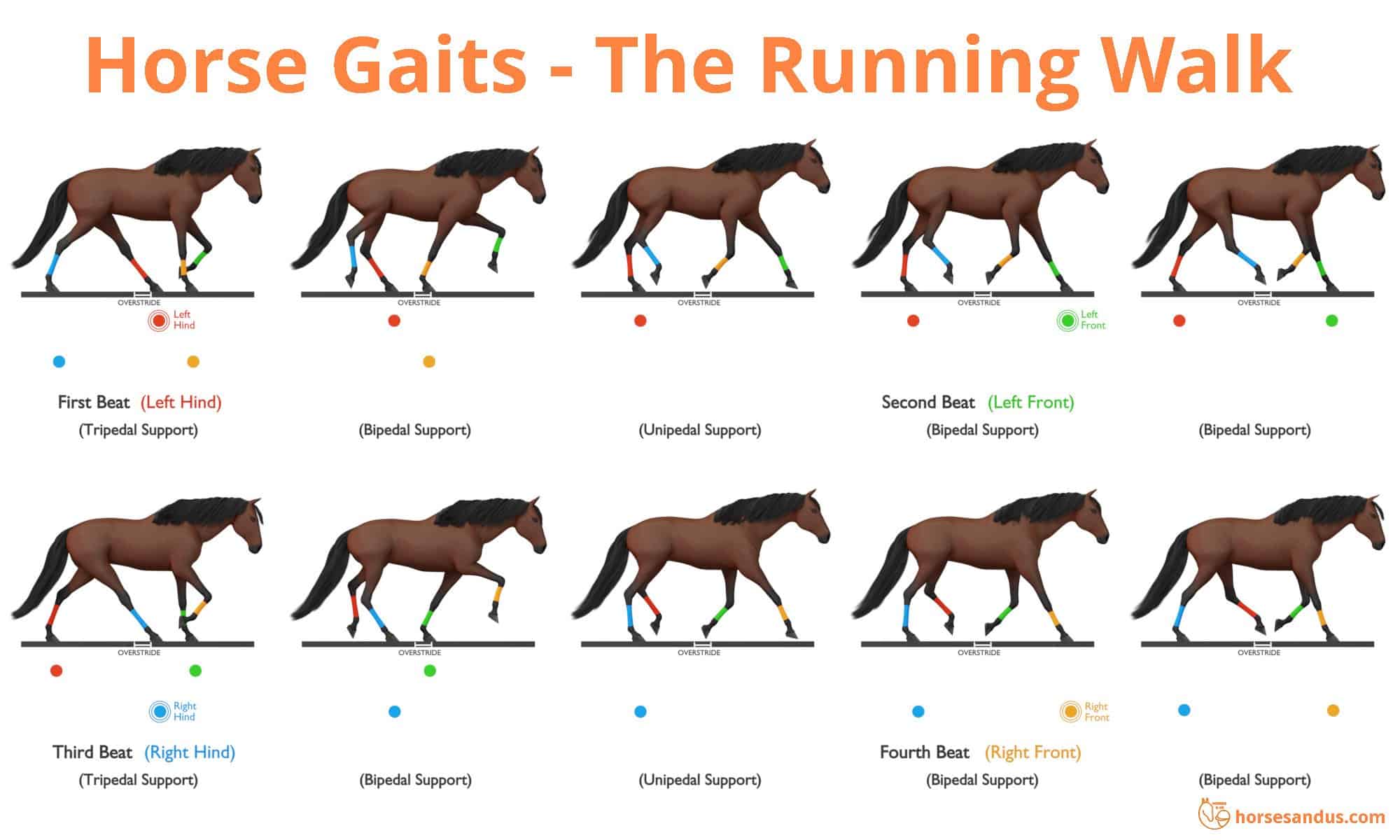
It is a symmetrical, four-beat, lateral gait.
The footfall sequence is left hindleg, left foreleg, right hindleg, right foreleg.
Ideally, the four footfalls are equally spaced in time.
The support phases can be unipedal (1-foot support), bipedal (2-foot support), and tripedal (3-foot support).
Animation of the Running Walk
The Canter (Rocking Chair)
The canter is one of the basic gaits common to all horses, but the Tennessee Walking Horse can perform it in a more comfortable and relaxed way.
The Tennessee walking horse performs a very beautiful and smooth canter which is often described as a “rocking chair canter” due to its high, rolling, uphill movement.
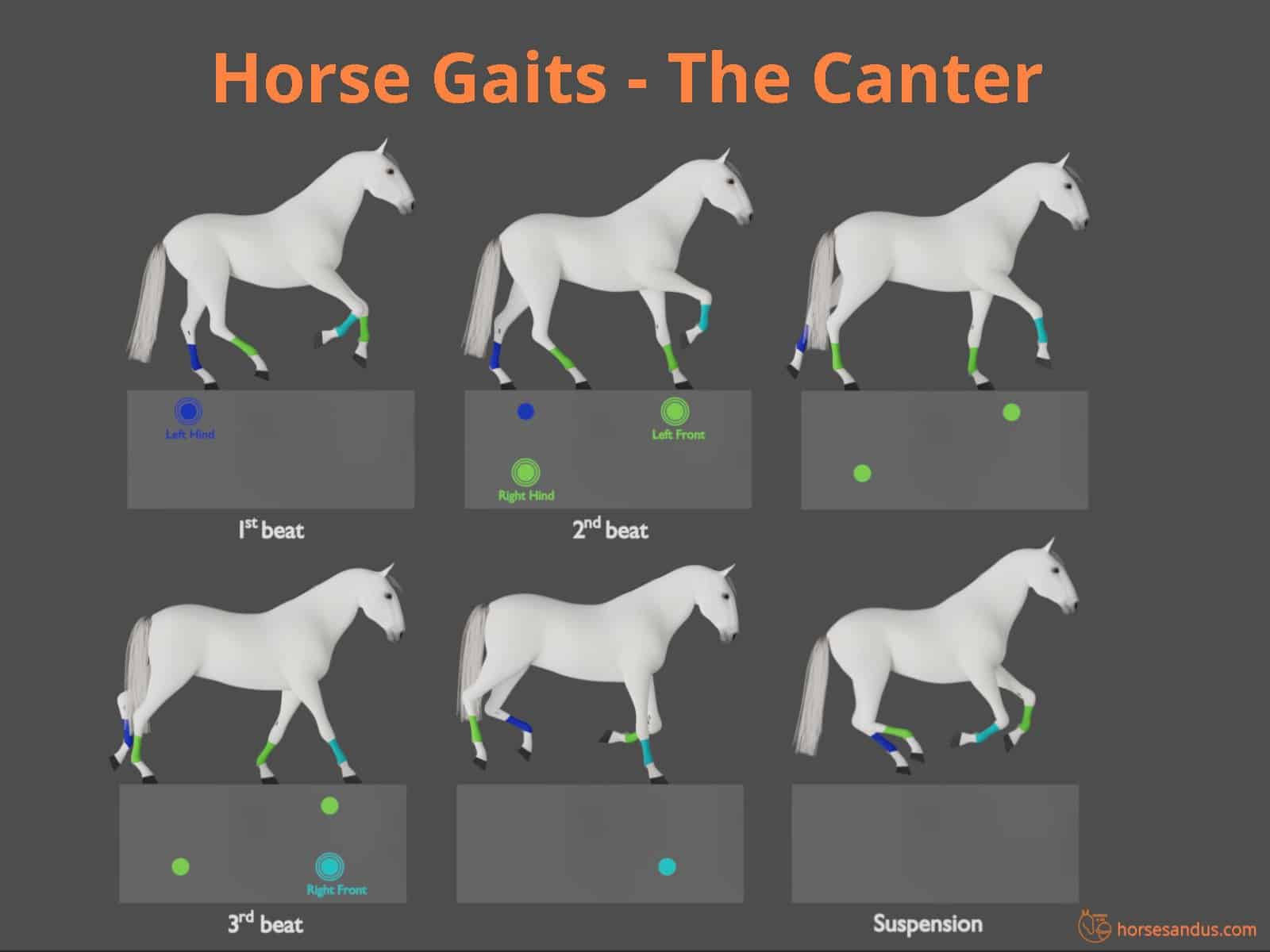
Is an asymmetrical, three-beat gait, with a suspension phase.
The footfall sequence is:
Left Lead Canter
Left Hind – Right Hind + Left Front – Right Front – Suspension
Right Lead Canter
Right Hind – Left Hind + Right Front – Left Front – Suspension
Animation of the Canter
History of the Tennessee Walking Horse
The Tennessee Walking Horse was created in the 18th century in the state of Tennessee. It was developed to satisfy the need for robust and comfortable riding horses that could travel long distances in the southern plantations.
1790
The first contribution was made around 1790 when Narragansett Pacers (the first US horse breed and now extinct) and Canadian Pacers brought from Kentucky were crossed with the gaited Spanish Mustangs brought from Texas.
The result of these crossings created the “Tennessee Pacers”.
Later on, other breeds, Morgan, Standardbred, Thoroughbred, and American Saddlebred were also added.
All these breeds blended together, created the Tennesse Walking Horse, which carries the best features from each breed.
It has the docile temperament of the Morgan, the athletic ability and speed of the Thoroughbred the movement of the standardbred, and the conformation of the Saddlebred.
Tennessee Walking Horses were mainly used as a utility animal for all types of farm work. It was also used for transportation and racing. At this time they were not yet used for showing.
1886
In 1886 the foundation sire of the Tennessee Walking Horse Breed, Black Allan, was born. It was the offspring of a Tennesse Walking Horse stallion and a Morgan Mare.
1935
In 1935 the Tennessee Walking Horse Breeders’ Association was formed.
1939
In 1939, the first “Tennessee Walking Horse National Celebration” was held. This is the largest horse show for the breed and is held annually in Tennessee.
This event has attracted a lot of attention in recent years, due to the controversy around the abusive practices used to enhance the horse’s gaits in the show ring.
1947
In 1947 the studbook was closed. This meant that from this date onwards a Tennessee Walking horse could only be registered within the breed studbook if both its parents were also registered.
1950
In 1950, the United States Department of Agriculture recognized the Tennessee Walking Horse as a distinct breed.
1960
By the 1960s, soring horses gained popularity. But public opposition to this practice also grew.
This is an abusive practice that inflicts pain on the horse’s legs. The pain causes the horse to lift its front feet off the ground more quickly, which results in a flashier gait, that has a better chance of winning at horse shows.
The Tennessee Walking Horse is one of the horse breeds most affected by soring.
1966
In 1966 the American Horse Protection Association was created. Among other issues, it also addressed the practice of soring.
1970
The Horse Protect Act of 1970 was passed. This law considers the practice of soring to be a crime that is legally punishable.
1974
The Tennessee Walking Horse Breeders’ Association changed its name to “Tennessee Walking Horse Breeders’ and Exhibitors’ Association” (TWHBEA), to manifest its interest in showing horses.
2000
In 2000 The Tennessee Walking Horse was named the official state horse of Tennessee.
2005
By 2005, 450,000 horses had been registered as Tennessee Walking horses. Most of these horses exist in the southern US, but they can be found all over the country and even the world.
2017
By 2017, the TWHBEA registered more than 520,000 horses and has approximately 19,000 members
The Ancestors of the Tennessee Walking Horse
The Tennesse Walking horse is a composite breed, which results from the fusion of many other breeds.
The earliest ancestors were the Narragansett Pacers, Canadian Pacers, and Gaited Spanish Mustang.
Over the years the Morgan, Standardbred, Thoroughbred, and American Saddlebred breeds were also added to the Tennessee Walking Horse Breed.
After 1947 the studbook was closed and no blood from other breeds can now be added.
What are Tennessee Walking Horses Used For?
Tennessee Walking Horses are very versatile.
They are excellent horses for pleasure riding and trail riding and are also suitable for endurance riding due to their docile temperament and smooth gaits.
They are very popular in horse show competitions.
They are also used for ranch work and western-style events such as reining and cutting.
Tennessee Walking Horse Show Competitions
There are two basic categories of the Tennessee Walking Horse show competitions: “Flat Shod” and “Performance”.
Flat-Shod Show Competitions
In these competitions, horses have normal horseshoes and are not allowed to use any additional devices such as pads, weights, or chains.
This competition category is becoming more popular because the general population is becoming more interested in preserving the natural gaits of the horse.
Performance Show Competitions
Performance horses wear stacked shoes and chains to accentuate their gaits. These devices cause the horse to lift their forelegs high off the ground producing flashy and animated gaits. This exaggerated movement is called “Big Lick”
In the past, soring the horse to produce flashy gaits was a common practice. But since the Horse Protection Act of 1970, this is considered a crime and prohibited by law.
This competition category is becoming increasingly under scrutiny of animal rights supporters.
7 Interesting Facts About Tennessee Walking Horses
The Tennessee Walking Horse has some interesting facts about it.
Here are a few.
1. It Is the official horse of the Tennessee state
The Tennessee Walking Horse was named the official state horse in 2000.
2. It derives its name from a US state and its unique gait
This breed originated in the US state of Tennessee and is known for its unique gait, the running walk. Hence the name Tennessee Walking Horse.
3. It is a composite breed
The Tennessee Walking horse results from the fusion of many other breeds – Narragansett Pacers, Canadian Pacers, gaited Spanish Mustangs, Morgan, Standardbred, Thoroughbred, and American Saddlebred
4. The Studbook is closed since 1947
In 1947 the studbook was closed, which means that a Tennessee Walking horse can only be registered within the breed’s studbook if both its parents are also registered.
5. It is known for its unique gait, the running walk
The Tennesse Walking Horse can perform 3 distinct gaits, the flat-foot walk, the running walk, and the canter. However, the running walk is unique to this breed and is the gait that made this horse famous.
6. Head nodding and overstriding are two features unique to the Tennessee Walking Horse
When performing the flat foot walk and the running walk the Tennesse Walking horse will nod its head-and-neck in rhythm to the feet movement and will perform a big overstride.
Other horse breeds typically do not show these features in such an expressive way.
7. is the breed most affected by the Horse Protection Act of 1970
This law considers soring as a crime and is legally punished.
The practice of soring was used in the past to accentuate the gaits by inflicting pain on the horse’s legs. Although this practice was used in a few gaited breeds it was most often seen in the Tennessee Walking horse.
Tennessee Walking Horse Breed Association
The Tennessee Walking Horse Breeders & Exhibitors Association (TWHBEA) was founded in 1935.
Its original name was Tennessee Walking Horse Breeders’ Association of America, but later in 1947, it was changed to the name it has now to express its interest in the show industry.
Its purpose is to register Tennessee Walking Horses and maintain their bloodlines.
By 2017, the TWHBEA registered more than 520,000 horses and has approximately 19,000 members.
Sources
The Dynamic Horse A Biomechanical Guide to Equine Movement and Performancehttp://www.ihwha.com/gaits.html
https://www.sciencedirect.com/topics/agricultural-and-biological-sciences/tennessee-walking-horse

